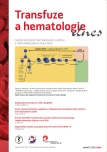P31. REBOUND BASOPHILIA DURING CYTOREDUCTION IN PATIENTS WITH CHRONIC MYELOID LEUKAEMIA
Authors:
L. Vráblová; L. Hrbečková; J. Zapletalová; M. Čerňan; E. Faber
Authors‘ workplace:
Department of Hemato-oncology, Faculty Hospital and Faculty of Medicine and Dentistry, Palacký University, Olomouc, Czech Republic
Published in:
Transfuze Hematol. dnes,27, 2021, No. 4, p. 337.
Category:
We defined the rebound basophilia (RB) as an increase at least 3% in relative proportion of basophils in WBC differential counts (WDC) in some chronic myeloid leukemia (CML) patients within the first month of cytoreduction treatment with hydroxyurea and/or imatinib.
We have analyzed 59 female and 80 male patients at median age of 58 years (range: 24–92), median follow-up of the patients was 6.3 years (range 3.5 months – 15.7 years). There were 56 cases of RB and 7 patients who were not in accelerated phase at diagnosis but fulfilled the criteria for CML acceleration at the time of RB occurrence. Statistically significant association of RB with younger age (P = 0.014; Kruskal-Wallis method), high risk Sokal score (P = 0.022), splenomegaly (P = 0.035), initial leukocytosis (P < 0.0001) and lactate dehydrogenase level (P = 0.044) was documented. Patients with RB have not increased mortality, either developed the progression of CML or required the treatment change more frequently. There were the trends for a later cytogenetic (Log-rank test P = 0.066) and molecular response (Log-rank test P = 0.076). The risk of disease progression, the treatment change or late achievement of molecular response were associated with absolute basophilia at diagnosis. Statistically significant difference between the change in relative number of basophils (P < 0,0001), the total number of leukocytes (P = 0.0001) and RB over time was proven. Patients with RB have significantly bigger decrease in leukocytes during cytoreduction.
RB may be encountered in about half of CML patients without any reason as infection. Its cause is unknown, it is associated with other CML risk features but it probably has not independent prognostic value. Further experiments and studies in the larger cohorts of patients are needed to reveal the causes of RB and to evaluate its possible prognostic role. Also prognostic role of absolute numbers of basophils at the diagnosis is warranted.
Supported by MZ ČR – RVO (FNOL, 00098892) .
Labels
Haematology Internal medicine Clinical oncologyArticle was published in
Transfusion and Haematology Today

2021 Issue 4
- Administration of aPCC as a Prevention of Bleeding After Major Cardiac Surgical Procedures
- The Importance of Hydration in Wound Healing
- Cost Effectiveness of FVIII Substitution Versus Non-Factor Therapy for Hemophilia A
- Vascular Disease in the Gradually Aging Population of Hemophiliacs: An Underestimated Problem?
- Prognostic Significance of Subclinical Joint Changes on MRI in Hemophilia
Most read in this issue
- Hypereosinophilia
- Congenital neutropenia in children and adults
- Neuro-immune interactions in the oncogenesis of multiple myeloma and their therapeutical relevance
- West Nile fever in the background of the COVID-19 pandemic
